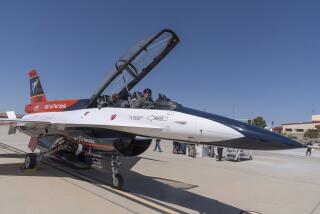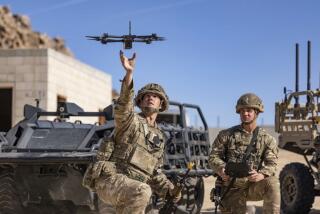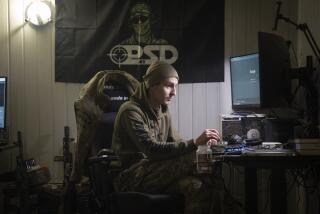War Is Hand-Held on Battlefield of the Future
- Share via
FT. IRWIN, Calif. — For nearly a century, the essential gear for the front-line infantry soldier has been a rifle, boots, canteen and helmet.
Soon, it may also include a hand-held computer linked to satellites.
U.S. military officials believe the system, developed by engineers at TRW Inc.’s research laboratory in Carson, could alter the way wars are fought by giving soldiers unprecedented access to battlefield information.
It marks a significant step toward the Pentagon’s goal of using information technology to defeat enemies before they have a chance to threaten American lives.
Last week, in the first major demonstration of the revolutionary concept, about 950 U.S. Army tanks and armored personnel carriers fought a mock battle here, 31 miles north of Barstow, outfitted with 10-inch computer monitors that told them instantly where they were, where they should go and where the enemy might be.
Aided by orbiting spy satellites, each crew was able to view a digital map of the landscape, including three-dimensional contours, that gave it a better overview of the skirmish than any general ever had.
Moreover, the commander in the operations center miles from the front line was able to monitor each vehicle, know its precise location and determine whether it needed a new supply of ammunition. The commander was then able to quickly come up with a battle plan before relaying orders to the crew’s computer monitor.
Eventually, Pentagon officials plan to outfit infantrymen with hand-held personal computer devices like the Palm, giving each soldier similar capabilities as the tank crew. The hand-held devices tap the video-game skills of young soldiers, enabling them to instantly pinpoint their position, find enemies and aim weapons.
‘Redefining War’
The infantry traditionally has ranked low on the Pentagon’s list of technology priorities. The Army receives only about 14% of the Pentagon’s annual $38-billion research and development budget. Of that, $86 million is spent on research into the troops’ food, clothing and equipment. The TRW system could be a huge boost for the soldier.
“We’re redefining war,” said Col. John F. Antal, commander of the 16th Cavalry Regiment at Ft. Knox, Ky., which coordinated the military exercise. “We’re demonstrating to America the power of information as an element of combat.”
The exercise here demonstrated for the first time the concept of a “digital” army, a radical new idea TRW engineers are helping to pioneer as the Pentagon looks to transform the military into a “faster, lighter and smarter” force. The mantra reflects post-Cold War realities in which U.S. troops are expected to fight swift regional skirmishes rather than set battles with heavy equipment, defense analysts say.
Taking cues from the Internet, the system relies on a complex network of wireless modems, satellite links and traditional human scouts to compile a computerized overview of a battlefield. Satellites provide a detailed outline of the landscape, and unmanned spy planes flying over the battlefield determine the enemy’s whereabouts.
The information is fed to computers on the battlefield linked by wireless modems.
The computers, with touch-screen monitors, display a map, showing blue icons for friendly forces and red icons for the enemy. Touching an icon instantly displays the identification of the vehicle and its precise location. The crew communicates with the command center as well as with each other via e-mail.
“It has the potential to greatly enhance the Army’s ability to fight,” said Loren Thompson, a defense analyst with the Arlington, Va.-based Lexington Institute.
If the system, known as Force 21 Battle Command Brigade and Below, is approved for mass use, the decision could be a boon to TRW and expand the role of Southern California’s defense industry.
The program is led by TRW’s Systems & Information Technology group in Redondo Beach. Raytheon Co.’s communications group in Fullerton and several other subcontractors are helping develop the system. Litton Data Systems in San Diego, now a Northrop Grumman subsidiary, is building the computers.
TRW has produced 2,000 units so far under a $57-million contract and recently received a $44-million option to deliver 1,600 systems by year-end. If it can demonstrate its abilities again in a second exercise later this year, TRW is expected to begin delivering 2,000 to 3,000 units a year, with a goal of installing them on 59,000 vehicles, a TRW spokeswoman said.
About 300 engineers have been working on the system, which eventually would be outfitted on every type of combat vehicle from M1A2 Abrams battle tanks and Bradley fighting vehicles to Humvees and mobile artillery carriers.
Standard Issue
If all goes according to plan, the Army wants to expand the wireless system to include the individual foot soldier using the hand-held devices. That system is slated to be tested in November and could help avoid accidental border incursions like the one that led to the capture of three U.S. soldiers in Yugoslavia a few years ago, Army officials say.
One feature may include an alarm that would go off on the hand-held computer if a soldier on border patrol crossed the line by mistake. A panic button also could be included for the soldier to instantly signal for help. Because the devices would be linked to a global-positioning satellite system, commanders would know the soldier’s precise location.
TRW also is developing a battlefield identification program that could electronically identify a U.S. soldier or vehicle and instantly distinguish it from the enemy. Army officials hope that such a system could dramatically reduce “friendly fire” incidents in which soldiers are mistakenly shot by their own.
For the Pentagon, moving to the so-called digital force could mean dramatic changes for the Army’s traditional command structure, in which future battles will occur so rapidly that a tank lieutenant may end up making the tough decisions usually reserved for higher-level commanders.
As such, the biggest challenge may not be technical but cultural, Army officials say. At first, soldiers may not know what to do with all the information they are getting, and the commanders may be reluctant to relinquish authority.
As more young recruits weaned on computers and video games join the military and as troops gain experience using the technology, some of the problems are likely to get resolved. But then the Army may face another psychological factor that worries the Pentagon. Soldiers could become too reliant on the computer and less on their own individual decision-making process.
During limited test runs at Ft. Hood, Texas, last year, some of the troops spent so much time learning how to operate and fix the computers that some of their basic skills, such as navigating with old-fashioned maps, suffered, according to Army officials. The maps still are critical, particularly if the computer crashes, they say.
For military strategists, last week’s exercise in California also reflected a new paradigm for the Army, one in which U.S. forces may never actually face their foes. In the new “maneuver” warfare, opposing forces would be held at bay by use of overwhelming firepower and information technology. Soldiers with the superior battlefield data would be able to attack swiftly from several directions--before the enemy could get off a shot.
The new type of fighting would mark a dramatic departure from the era of “attrition warfare,” in which soldiers engage the enemy directly, similar to that practiced during World War II, analysts say.
Early Problems
After four years of field tests, last week’s exercise was the first time the Army has been able to show some success. Older-model computers tended to crash. And the General Accounting Office has questioned the way the new one is being deployed, arguing that more time should be spent testing it.
Pentagon officials acknowledge some initial reliability problems with the system but insist that with more powerful computers and advances in communication technology, many of the kinks are being worked out.
In one mock battlefield encounter two weeks ago, a tank crew was able to destroy 15 enemy vehicles using information gleaned from its computer. The opposing force, known as the Red Team, was composed of experienced Ft. Irwin veterans who regularly fight visiting brigades as part of the training exercise--and typically overwhelm them.
In addition, the opposing force was unable to disable, crack or jam the system, its primary mission, after nearly two weeks of head-to-head battles, Army officials said.
Critics have contended that the system could easily be disrupted. Also, if one of the computers was captured, it could provide invaluable information to the enemy, critics say.
But TRW officials said the system is designed with security measures that include a self-destruct button that literally fries a computer within 15 seconds, rendering it useless. And the systems can be remotely shut off by commanders. Computers also communicate with specially designed encrypted links and password protection.
Pentagon officials said it will take months to analyze the outcome of the latest exercise, but supporters already seemed to gain a morale victory.
The 4th Infantry Division’s mechanized brigade from Ft. Hood--the Blue Team--put up a “good fight” despite going up against a battle-tested “enemy” that knew the terrain. The Red Team did not have the new equipment.
“In the past, we saw them rolling right over the Blue forces,” Col. Antal said. “That didn’t happen this time. There were some grinding fights.”
*
Additional photos are available at http://pyxis.nohib.com./soldier.
More to Read
Sign up for Essential California
The most important California stories and recommendations in your inbox every morning.
You may occasionally receive promotional content from the Los Angeles Times.










